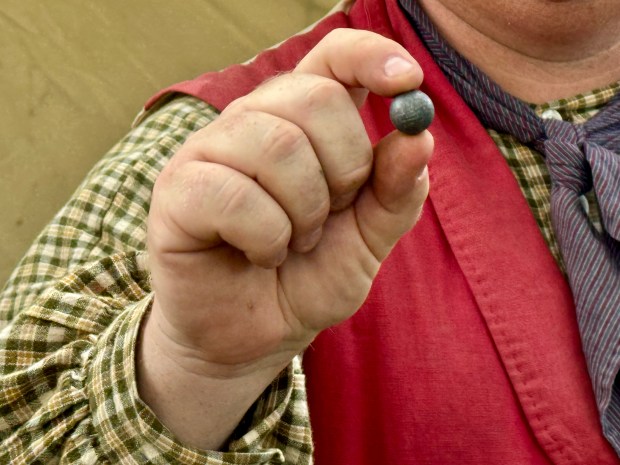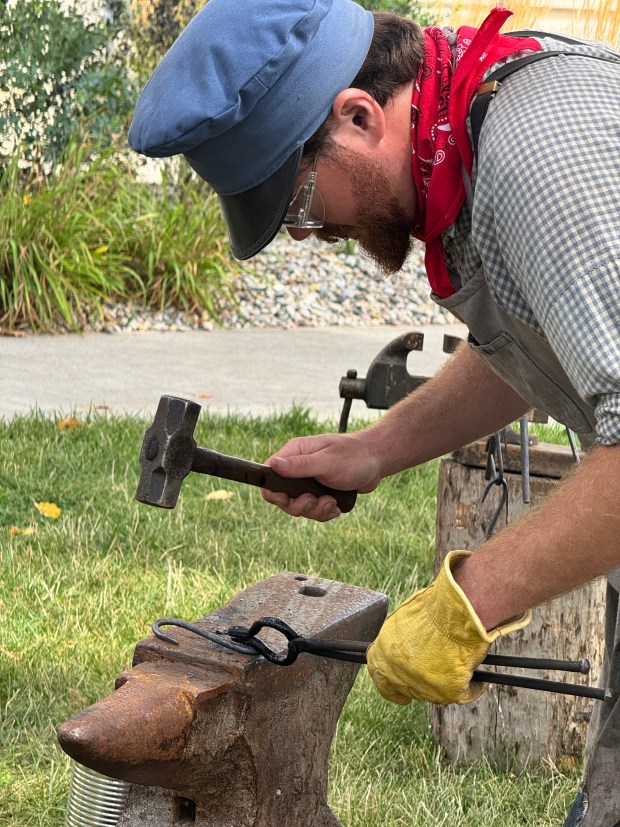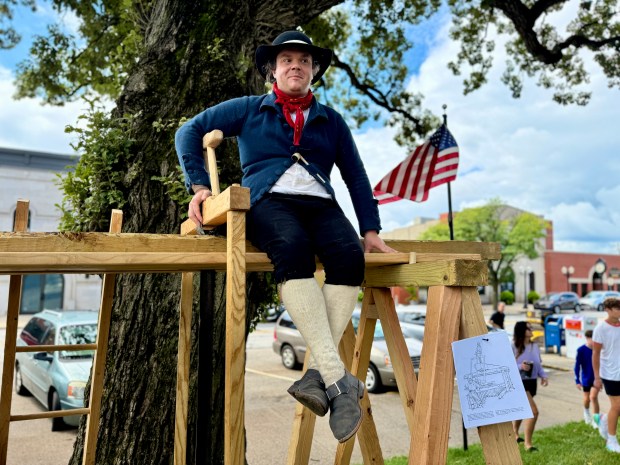History came to life on the Porter County Courthouse lawn Saturday in Valparaiso as reenactors showed some common trades in the nation’s early days.
Holly Shaffer, of LaPorte, spun a yarn while showing how to spin wool and flax into yarn.
“It’s therapeutic. I Iike the historical aspect,” she said.
“I picked up crochet in first grade,” Shaffer said. After buying a drop spindle, the type used thousands of years ago, she taught herself how to spin one day. The following day, she was recruited as a volunteer, showing others at the LaPorte County Fair how to spin yarn.
Wool and flax were the two raw materials used by pioneers in Indiana’s early days. Flax, a type of plant fiber, was used to create linen. Mix wool and flax, and you would get linsey-woolsey, she explained.
“I’ve heard it takes a year to go from sheep to shirt,” Shaffer said.

She showed a large spinning wheel design that dates to the early medieval period. The smaller Norse Saxony wheel from the 1500s — the type used to spin gold in the Rumpelstiltskin fairy tale — was a technological improvement. “This one’s powered by my foot instead of myself walking back and forth,” Shaffer said.
Among the reasons for the American Revolution, she said, was the industrialization of weavers. England exported finished cloth but not the steam-powered technology to create it, forcing American settlers to either pay a premium for the imported fabric or labor long hours to create it themselves.
Dako Morfey, owner of Marble Top Antiques, performed as a night watchman. “Punitive action wasn’t really in my purview, but it wasn’t really outside of it either,” he said.

Night watchmen weren’t like modern police, Morfey said. Night watchmen were on the alert for fires, checked locks and dealt with uncooperative drunks, escorting them home to make sure they safely slept it off.
In rare circumstances, a drunk would be belligerent and have to be held in the night watchman’s office overnight to face a magistrate.
Magistrates meted out punishment, which could be “brief and harsh,” like putting the offender in stocks for the public to taunt and possibly throw overripe fruit at.
For crimes like adultery, a hot brand on the face or hands could make the offender a virtual outcast, humiliated by a permanent brand. In severe cases, the offender could become a literal outcast, expelled from the community and ordered not to return.
But crime and fires weren’t the only dangers night watchmen had to deal with. There were instances of wolves snatching children from their beds, too, Morfey said.
John Cardinal, of Lansing, Michigan, encouraged attendees Saturday to help him saw a board on a large trestle. The saw took two people to operate. The volunteer underneath the trestle pulled the blade down, performing the cut, then Cardinal pulled it back up to get the blade in position for the next cut.
“This is how they would have cut boards before sawmills,” Cardinal said.
It was a lengthy process. It could take a two-man team 10 hours to produce 12 poplar boards, first using axes to remove bark and roughly square the log, then the large saw to follow a chalk or charcoal line to produce the finished board.
Cardinal built the trestle using pegs and a mortise and tenon technique. Not until the late 1800s were nails used to frame a house, he said. Prior to that, nails were used for making furniture, Cardinal said.
Solomon Burgo, of Fish Lake, made pot hooks using his portable forge and a 160-pound anvil. “I guess I was always interested in tools and weapons and things,” he said, so 10 years ago he tried his hand at blacksmithing as a hobby.
After heating rods to make them pliable, Burgo used the anvil’s horn to hammer the rod until it formed the desired curve. Afterward, he used beeswax to deter rust.
Ian Baker, of Michigan City, learned gunsmith skills because of his hobby of being a reenactor.
“You start off cleaning them and fixing them and modifying them. It’s just kind of a rabbit hole you fall into,” he said.
Baker showed a rifle he made. “This is smooth bore, and I can hit something 100 yards away,” he said.
He first showed visitors a flintlock rifle. “Your gun literally relies on a rock,” he said. The flint creates the spark that ignites the powder. “A rainstorm might turn that into a club.”
Next, he held a rife that used a percussion cap filled with fulminated mercury. “This is worlds more reliable than a flintlock,” he said. The rifle “started life as a flintlock rifle in the 1820s in Belgium,” Baker said, but was modified to use percussion caps.
He showed two types lead shot — the small round balls created using a shot tower 50 to 60 feet tall, with lead poured through a screen and dropped into a pool of water below. Homemade swan shot isn’t as elegant as its name implies. “It’s not as pretty, it’s not as aerodynamic, but you can still load it into a shotgun,” Baker said.
“Lead has a very low melting point, so it’s easy to cast things yourself over a campfire,” something soldiers and frontiersmen did on long campaigns, Baker said.
Doug Ross is a freelance reporter for the Post-Tribune.





